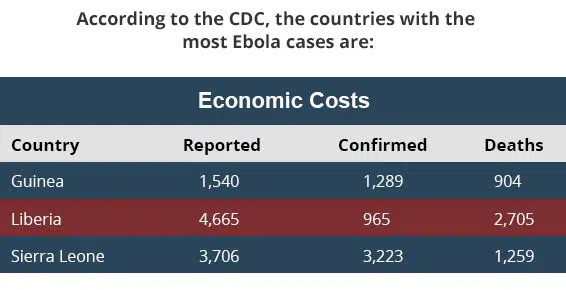People are free to debate whether the media has sensationalized the threat that the Ebola virus poses to the United States. However, with Ebola cases being reported in Dallas and, most recently, New York City, it is clear that this issue merits serious attention – especially in the context of the workplace.
On October 21, for instance, the National Safety Council issued a statement in which it urged employers to assess their employees’ risk of Ebola exposure and to make sure that procedures are in place to prevent or control transmission of the deadly virus.
The AFL-CIO has also called for workplace safety rules that address the issue of Ebola exposure, according to Bloomberg News.
As a law firm that protects the rights of those who suffer work-related injuries and illnesses, Frank M. Eidson, P.A., joins those organizations in asking employers – especially those in the health care industry, airline industry and government agencies involved in emergency response – to assess their readiness to deal with Ebola and review their policies for dealing with exposed workers.
We hope the following, based primarily on information found at the U.S. Centers for Disease Control and Prevention website, can be helpful in understanding Ebola and the importance of addressing risk of exposure in the workplace.
What is Ebola?
Ebola is a common term for “Ebola hemorrhagic fever.” It occurs when a person becomes infected by one of four Ebola virus strains that can cause disease in humans. The strains are carried by animals, including bats and primates.

In the U.S. and Europe, there have been 18 cases of the disease, including confirmed cases in Dallas and New York City, through October 24, 2014. See this New York Times graphic for an excellent look at how one person can lead to a “cascade” of exposure. You should also check out the Times’ report on the confirmed case of a New York City doctor infected with Ebola.
The World Health Organization reports that, internationally, the Ebola outbreak could lead to 10,000 new cases per week by December, according to the New York Times.
How Is Ebola Spread?
The CDC reports that Ebola can be transmitted through direct contact with the blood or bodily fluids of an Ebola-infected person. Examples of bodily fluids include saliva, sweat, urine, feces, and vomit.
It can also be spread by direct contact with contaminated objects such as syringes and needles. This is why healthcare workers face the highest risk of exposure to Ebola.
The New York Times reports that doctors at Atlanta’s Emory University Hospital have discovered that the virus may also be present on a person’s skin.
Ebola cannot be spread by water or through the air, the CDC reports. Mosquitoes cannot spread the Ebola virus, either.
What Are Signs and Symptoms of Ebola?
The CDC reports that a person infected with the Ebola virus may display the following signs and symptoms, which may take between 2 to 21 days to appear (and usually between 8 to 10 days).
- Severe headache
- Fever
- Muscle pain
- Weakness
- Diarrhea
- Vomiting
- Stomach pain
- Bleeding or bruising.
If a person displays these symptoms after coming into direct contact with a person or animal infected with Ebola, the person should be immediately isolated, and public health professionals should be immediately notified, the CDC states.
How Is Ebola Diagnosed and Treated?
The Mayo Clinic states that it is difficult to diagnose Ebola because initial signs and symptoms are similar to other illnesses such as malaria. If the Ebola virus is suspected, doctors would order blood tests such as:
- ELISA – Enzyme-linked immunosorbent assay
- PCR – Reverse transcriptase polymerase chain reaction.
The U.S. Food and Drug Administration (FDA) has not approved any antiviral medication for Ebola treatment, although the agency is currently reviewing several applications for experimental drugs, according to The National Journal.
As a result, the course of treatment for Ebola patients typically involves the following, according to the Mayo Clinic:
- Providing fluids to prevent dehydration
- Maintaining a patient’s blood pressure
- Providing oxygen
- Replacing lost blood (blood transfusions).
What is Being Done to Prevent Employees’ Exposure?
According to the New York Times, the CDC has come out with an exhaustive, highly detailed description of the gear that should be used by healthcare workers to prevent Ebola exposure. The gear includes gloves, headgear, protective clothing and rubber boots. (See this graphic).
However, while it is imperative that all employers have policies in place that not only address how to prevent exposure, they should also establish how they will react to a worker being infected with the Ebola virus. In particular, the policy should address how an Ebola survivor can be safely reintegrated into the workplace.











